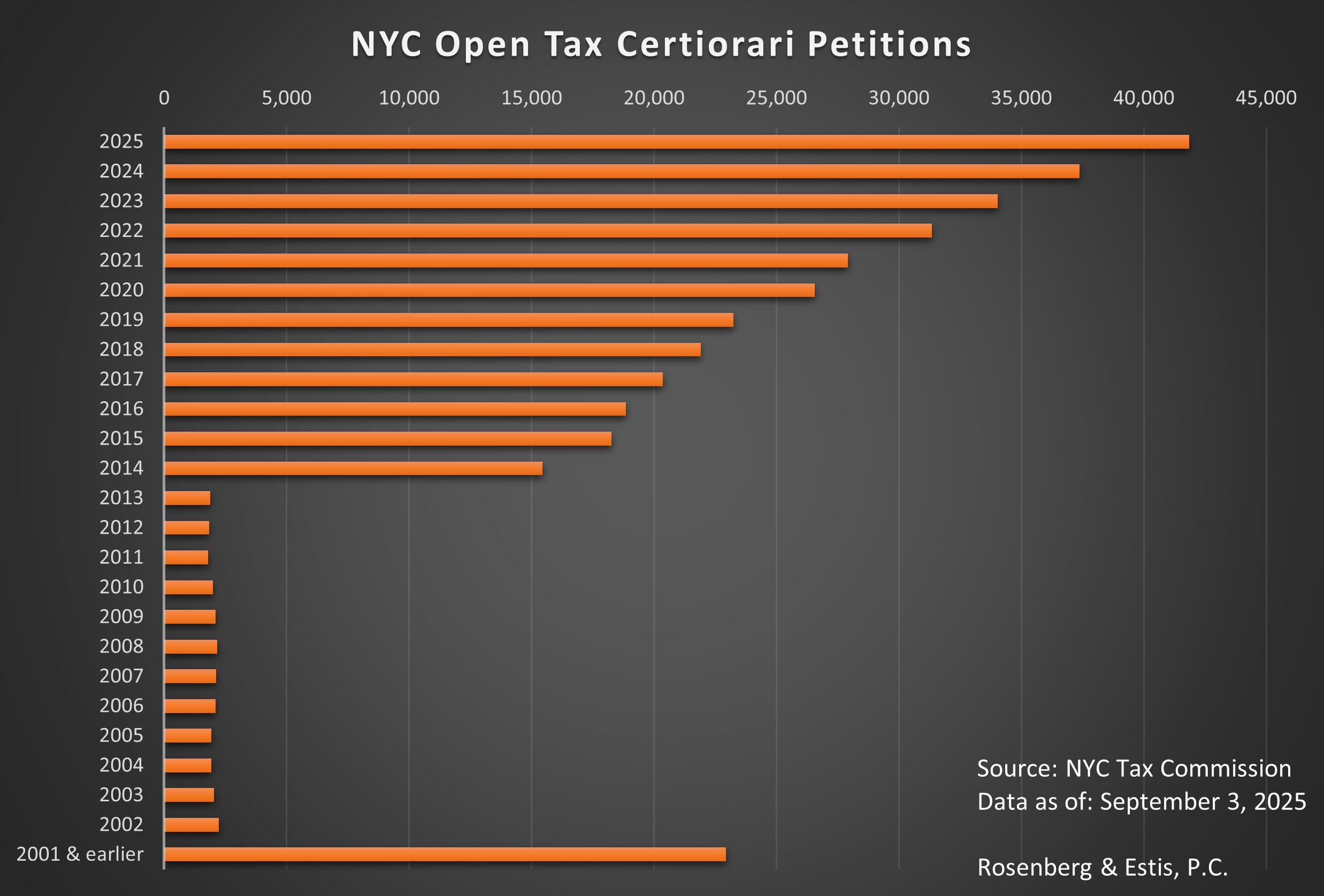NYC Property Tax

NYC Open Tax Certiorari Petitions by Year
Published 10/20/2025 at 12:42 PM
By: Benjamin M. Williams

The year indicated in the above chart is how the city denotes the fiscal tax year ending. So the latest data we have, which is year “2025” in the chart, is for the 2024/25 fiscal tax year. These would be petitions filed in 2024 by the October 24, 2024 deadline.
I recently wrote about filing real property tax certiorari petitions and why we file them, see my blog: Article 7 Filing Season: File by October 24, 2025 to preserve your 2025/26 NYC property tax challenge
I also recently wrote about pending real property tax certiorari cases in New York City. These are cases that not only have filed petitions, but are actively pursuing them in court. I wrote that the number of pending cases reached a record high of 2,088 (as of August 17, 2025). See my blog: Real Property Tax Certiorari Caseload Trends in NYC
Beth Wang quoted me on October 17, 2025, in her article for Bloomberg Law about New York City’s many “open petitions.” See: Appealing Your NYC Property Taxes? Don’t Expect a Quick Answer
Beth wrote:
The filings are part of an annual song and dance for attorneys, the Tax Commission, the New York City Law Department, and the court system. There are nearly 300,000 or more open petitions—including a handful dating back to the 1970s and petitions submitted over multiple years for the same lot—that have been filed with the court, according to Tax Commission data. Nearly 200,000 of those were filed in the past five years, and more than 2,100 are awaiting trial.
There are just four judges in the entire city to handle the thousands of cases that reach them—and several other reasons for the city to slow-roll the process.
The Tax Commission’s latest data file, with data as of September 3, 2025, excludes petitions filed for the current 2025/26 tax year. The data file has 364,129 lines, where each borough, block, lot, index number, and year have a unique line. Petitions can cover multiple lots, especially some condo lot ranges. In those cases, the same index number and year could be listed several times. Looking at unique petitions only, there are 289,351. Of those, 34,279 are for tax year 2024/25 (as opposed to the line-count method of 41,857).
You can see in the chart that the number of petitions (lines) decreases. Each year averages about -8.5% less than the subsequent year. The decrease in the number of open older petitions is due to later settlements. If you accept a Tax Commission reduction offer in 2025, you must discontinue your prior proceedings – meaning you must close-out your open petitions for all prior years, if any.
The Tax Commission Open Petitions file lists information in the City’s computer records with respect to open petitions challenging real property tax assessments pursuant to Article 7 of the Real Property Tax Law: the index number and year the petition was commenced, the name of the petitioner, the name of the attorney for the petitioner, and various note of issue codes. The codes you may see are:
- “1” for filing a certified statement of income and expenses with the Law Department;
- “2” for filing a note of issue;
- “3” for defective petition because the Tax Commission dismissed the predicate application;
- “4” marked off court calendar, but deemed open by the Tax Commission; and
- “5” for a fifth-year extension under RPTL §718 agreed to with the Law Department
- “0” or a blank means there is no code.
Petitions that are invalid or abandoned are closed on the City’s records of assessment review petitions. Only open petitions appear on this report. Generally, inactive petitions filed more than 15 years ago have been marked as closed.
Note the big drop from 2013/14, to 2012/13 and earlier. For tax years 2012/13 to 2001/02, the average number of open petitions is 2,000 per year.
Many of the petitions that have been open for more than four or five years may still appear on this list despite being abandoned if no Note of Issue was filed or Certified Statement of I&E (Law Department Audit Report Form) was filed.